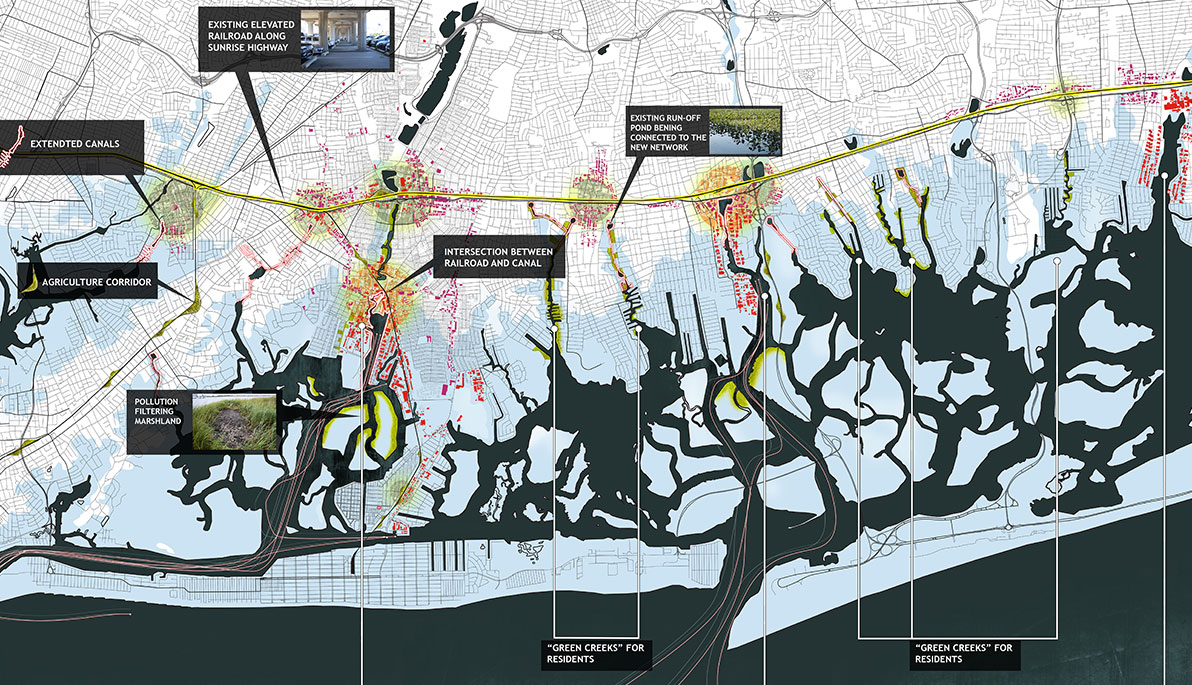News
Architecture Students Put Their Designs "In Harm's Way"
November 30, 2017
Architecture student Minh Nguyen is ready to transform Long Island’s South Shore.
Together with classmates Erik Jakob, Waisuddin Azizi, and Tom Meade, he proposed short- and long-term solutions that lay the groundwork for a gradual transformation of Long Island’s south shore communities that were ravaged during Hurricane Sandy in 2012.
Their project, titled “Green Wave,” was one of three NYIT student designs on display in In Harm’s Way, an exhibition hosted at the Long Island Museum in Stony Brook, N.Y., from October 6 to December 31. To coincide with the fifth anniversary of Hurricane Sandy, the museum also hosted a symposium featuring architects, government officials, and community members discussing ways to improve Long Island’s resiliency to future storms.
“This exhibition and symposium is the climax of a semester of applied research investigating how architects might respond to a changing climate and rising tides,” says Robert Cody, associate dean in NYIT School of Architecture and Design, who moderated a panel at the symposium.
In addition, Cody along with Associate Professors Matthias Altwicker and Jeffrey Raven coordinated design studios in Long Island and Manhattan. (Adjunct Professor Manuel Garza served as co-professor along with Cody for the Long Island studio.) Then, students presented their projects at an annual community design competition sponsored by the School of Architecture and Design. “Green Wave” won first place and was chosen by the curator of the Long Island Museum for the exhibition. Two other winning designs were also shown.
Describing his team’s project, Nguyen says, “My group’s approach was to transform a terrestrial suburbia into an amphibious existence that can thrive on the rising water.” For example, as more Long Island residents move toward urban “nodes” located along the railway lines, the group considered using an existing elevated Long Island Railroad system as a means of emergency transportation. “It would only become more critical in the future since the ground level as we know it today will be claimed by water,” Nguyen adds.
Additional design elements included creating new agricultural landfills along the railways to grow crops locally. “In case of an emergency, these green hills should at least be enough to sustain each neighborhood for short periods of time while waiting for help to arrive,” he says.
For Nguyen, the experience highlighted the pitfalls of Long Island’s suburban planning. “[Will the current] suburban lifestyle really stand up to future scientific scrutiny?” he asks. “In the age of sustainability and minimal building footprint, how do we preserve cultural values in the flood zones where many residents have currently chosen to live while still preparing for future threats?”
“The exhibited student projects present a future view into a world with elevated sea levels and communities living with the water, not against it, just as they did a century ago,” says Cody. “We hope that through this effort, our future architects will continue to debate, consider, and work toward a more resilient and sustainable future.”
Another team’s project, “Cradle the Bay,” envisioned building “Venice” on Long Island. Architecture student Shivanie Muneshwar says, “We challenged ourselves to design and plan a new lifestyle for the people of Bay Park, Barnum Island, Island Park, Harbor Isle, and parts of Oceanside.”
Inspired by the canal systems of the historic Italian city, Muneshwar and her partners Arkadiusz Chrobak, Marissa Marzullo, and Vanessa Rocha proposed using prefabricated housing to create communities. “We had to consider lots of different factors that would affect this community,” she adds. “Our planning strategy focused on rebuilding the existing marshlands as a recreational zone, while also providing a new barrier for the bay that was severely damaged. We intended for the community to shift to an entirely water-based transportation system replacing all cars with boats, using the dredged streets as waterways. This will ensure that no home near the coast would have water damage. During storm surges, the water will be able to fill up the canals, decreasing the impact on the island.”
Muneshwar acknowledges that her team’s bold design (which won third place in the competition) was “intense and elaborate” but says that when it comes to ensuring the safety of residents, all architectural and urban planning designs should be considered.
“How much is too much?” she asks, “When it comes to saving a community from future destruction, is it ever too much?”
“Cradle the Bay” took third place in the competition. Students proposed building a new “Venice” in Long Island. Their plan calls for using prefabricated housing to create communities that incorporate water-based transportation inspired by Venice’s famed canals.
View “Cradle the Bay” PDF“Green Wave” won first place in the competition associated with the exhibit In Harm’s Way. The project features short- and long-term solutions for the gradual transformation of Long Island’s south shore communities that were ravaged during Hurricane Sandy in 2012.
View “Green Wave” PDF



_Thumb.jpg)


